Analysis of Sustainable Tourism Development in the Philippines
VerifiedAdded on 2020/02/03
|22
|6633
|165
Report
AI Summary
This report delves into the realm of sustainable tourism development, focusing on the case of the Philippines. It meticulously examines the benefits stakeholders derive from tourism planning, encompassing community members, local and national governments, and NGOs. The report contrasts the advantages and disadvantages of public and private sector involvement in tourism planning, highlighting their respective roles and impacts. It further explores the features of tourism development planning at international, national, and local levels, emphasizing the significance of interactive planning systems. The report evaluates methods for measuring tourism's impact, addresses conflict resolution strategies, and analyzes the implications of balancing supply and demand within the tourism sector. Furthermore, it scrutinizes the moral and ethical considerations of enclave tourism and identifies current issues and future recommendations for sustainable tourism development. The report concludes with a synthesis of the key findings and proposes actionable strategies for the Philippines to enhance its tourism sector.
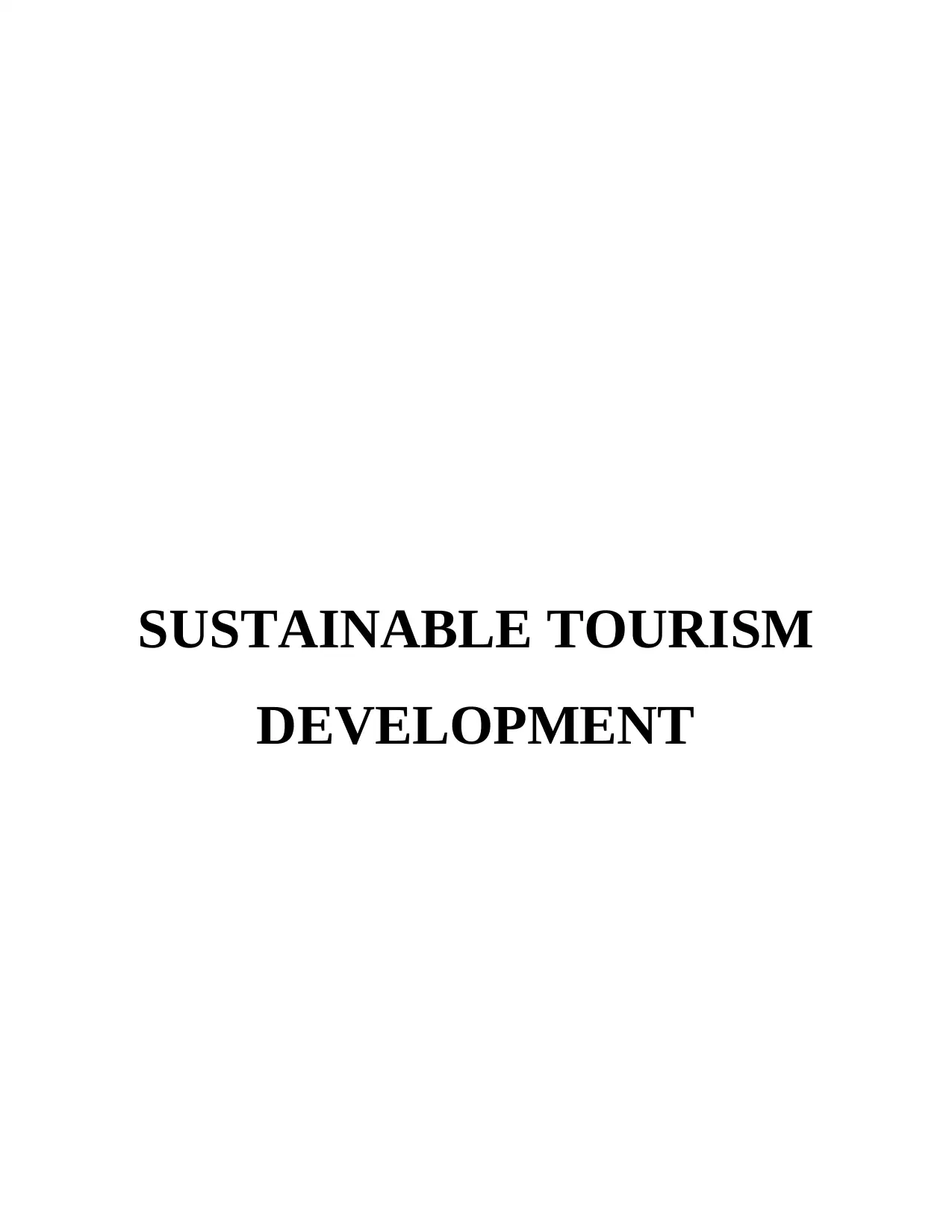
SUSTAINABLE TOURISM
DEVELOPMENT
DEVELOPMENT
Paraphrase This Document
Need a fresh take? Get an instant paraphrase of this document with our AI Paraphraser
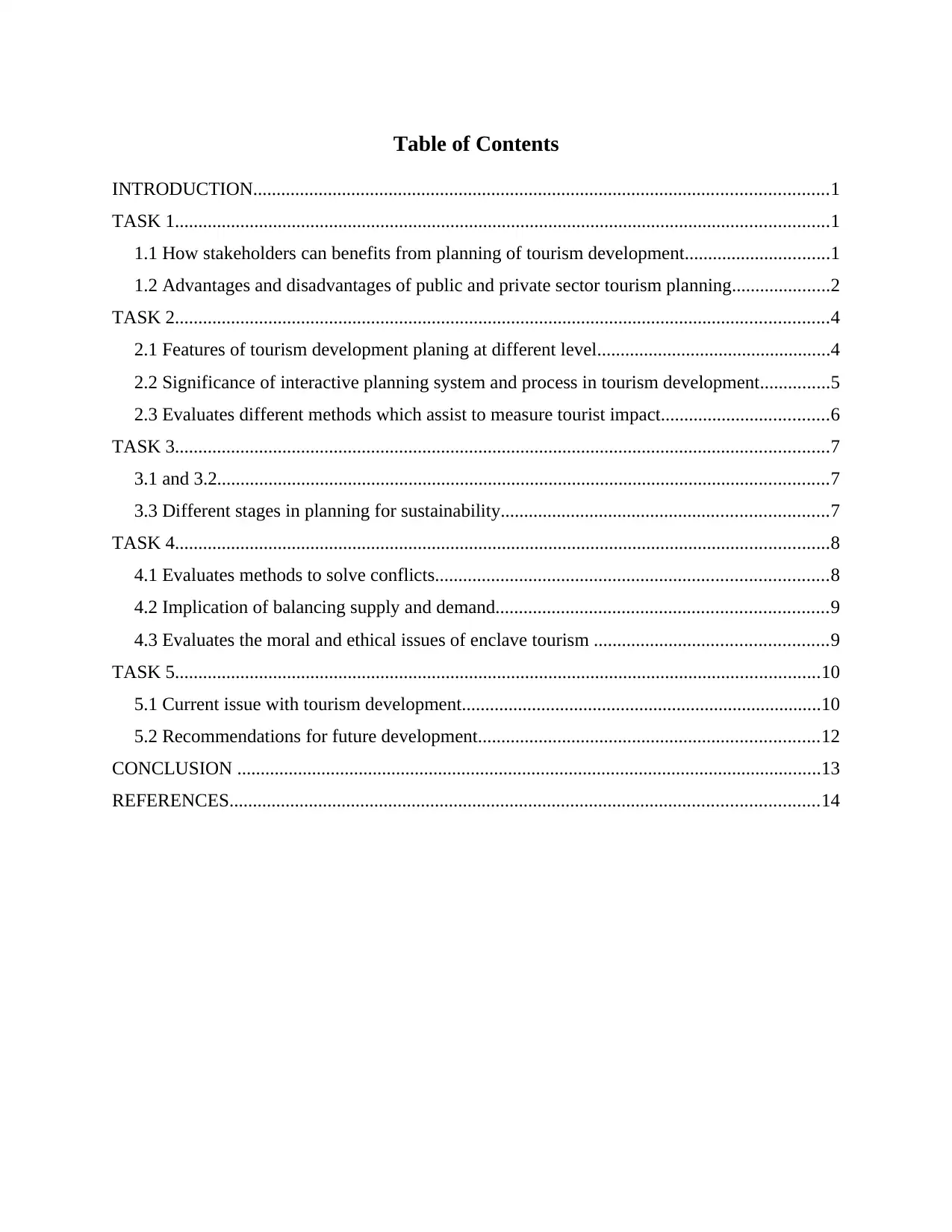
Table of Contents
INTRODUCTION...........................................................................................................................1
TASK 1............................................................................................................................................1
1.1 How stakeholders can benefits from planning of tourism development...............................1
1.2 Advantages and disadvantages of public and private sector tourism planning.....................2
TASK 2............................................................................................................................................4
2.1 Features of tourism development planing at different level..................................................4
2.2 Significance of interactive planning system and process in tourism development...............5
2.3 Evaluates different methods which assist to measure tourist impact....................................6
TASK 3............................................................................................................................................7
3.1 and 3.2...................................................................................................................................7
3.3 Different stages in planning for sustainability......................................................................7
TASK 4............................................................................................................................................8
4.1 Evaluates methods to solve conflicts....................................................................................8
4.2 Implication of balancing supply and demand.......................................................................9
4.3 Evaluates the moral and ethical issues of enclave tourism ..................................................9
TASK 5..........................................................................................................................................10
5.1 Current issue with tourism development.............................................................................10
5.2 Recommendations for future development.........................................................................12
CONCLUSION .............................................................................................................................13
REFERENCES..............................................................................................................................14
INTRODUCTION...........................................................................................................................1
TASK 1............................................................................................................................................1
1.1 How stakeholders can benefits from planning of tourism development...............................1
1.2 Advantages and disadvantages of public and private sector tourism planning.....................2
TASK 2............................................................................................................................................4
2.1 Features of tourism development planing at different level..................................................4
2.2 Significance of interactive planning system and process in tourism development...............5
2.3 Evaluates different methods which assist to measure tourist impact....................................6
TASK 3............................................................................................................................................7
3.1 and 3.2...................................................................................................................................7
3.3 Different stages in planning for sustainability......................................................................7
TASK 4............................................................................................................................................8
4.1 Evaluates methods to solve conflicts....................................................................................8
4.2 Implication of balancing supply and demand.......................................................................9
4.3 Evaluates the moral and ethical issues of enclave tourism ..................................................9
TASK 5..........................................................................................................................................10
5.1 Current issue with tourism development.............................................................................10
5.2 Recommendations for future development.........................................................................12
CONCLUSION .............................................................................................................................13
REFERENCES..............................................................................................................................14

⊘ This is a preview!⊘
Do you want full access?
Subscribe today to unlock all pages.

Trusted by 1+ million students worldwide
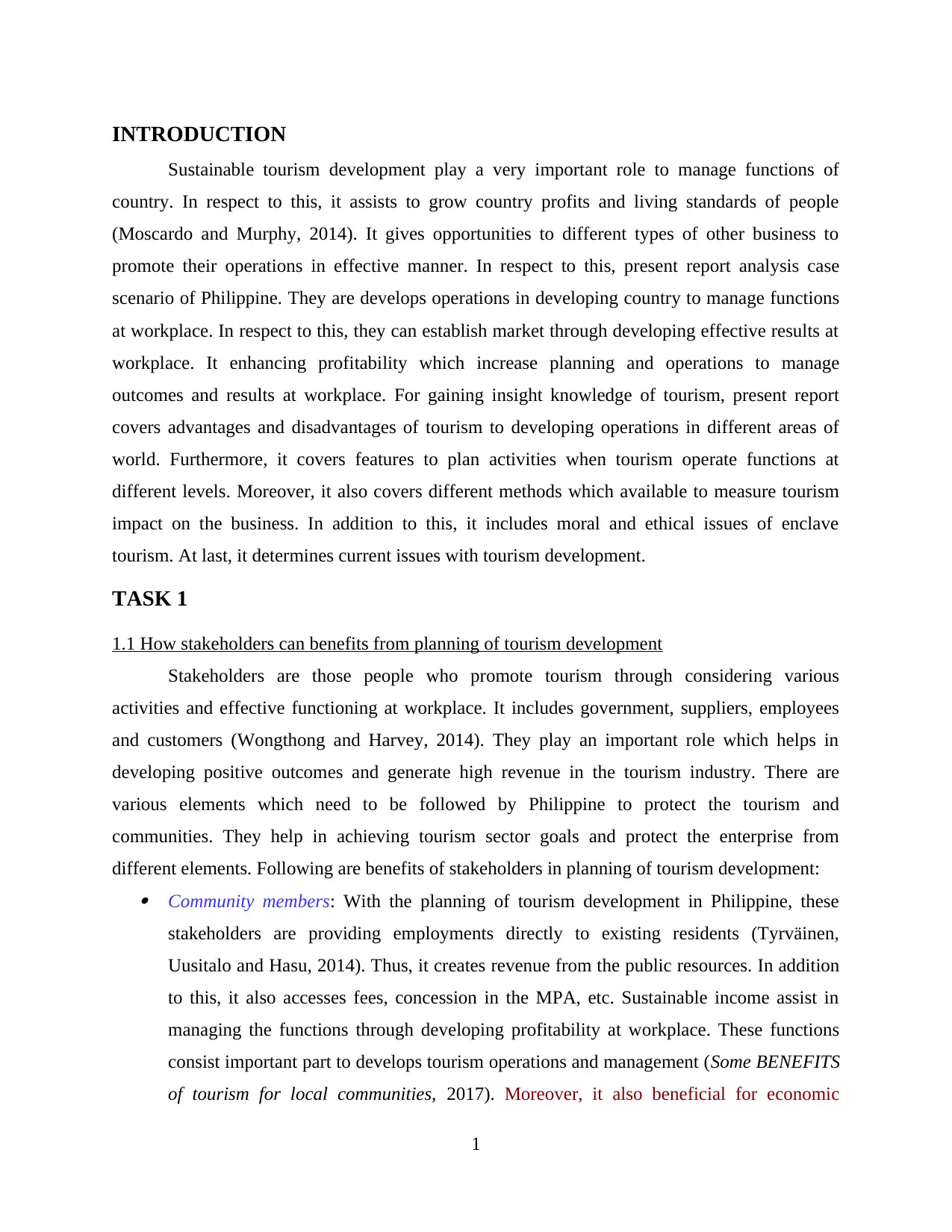
INTRODUCTION
Sustainable tourism development play a very important role to manage functions of
country. In respect to this, it assists to grow country profits and living standards of people
(Moscardo and Murphy, 2014). It gives opportunities to different types of other business to
promote their operations in effective manner. In respect to this, present report analysis case
scenario of Philippine. They are develops operations in developing country to manage functions
at workplace. In respect to this, they can establish market through developing effective results at
workplace. It enhancing profitability which increase planning and operations to manage
outcomes and results at workplace. For gaining insight knowledge of tourism, present report
covers advantages and disadvantages of tourism to developing operations in different areas of
world. Furthermore, it covers features to plan activities when tourism operate functions at
different levels. Moreover, it also covers different methods which available to measure tourism
impact on the business. In addition to this, it includes moral and ethical issues of enclave
tourism. At last, it determines current issues with tourism development.
TASK 1
1.1 How stakeholders can benefits from planning of tourism development
Stakeholders are those people who promote tourism through considering various
activities and effective functioning at workplace. It includes government, suppliers, employees
and customers (Wongthong and Harvey, 2014). They play an important role which helps in
developing positive outcomes and generate high revenue in the tourism industry. There are
various elements which need to be followed by Philippine to protect the tourism and
communities. They help in achieving tourism sector goals and protect the enterprise from
different elements. Following are benefits of stakeholders in planning of tourism development: Community members: With the planning of tourism development in Philippine, these
stakeholders are providing employments directly to existing residents (Tyrväinen,
Uusitalo and Hasu, 2014). Thus, it creates revenue from the public resources. In addition
to this, it also accesses fees, concession in the MPA, etc. Sustainable income assist in
managing the functions through developing profitability at workplace. These functions
consist important part to develops tourism operations and management (Some BENEFITS
of tourism for local communities, 2017). Moreover, it also beneficial for economic
1
Sustainable tourism development play a very important role to manage functions of
country. In respect to this, it assists to grow country profits and living standards of people
(Moscardo and Murphy, 2014). It gives opportunities to different types of other business to
promote their operations in effective manner. In respect to this, present report analysis case
scenario of Philippine. They are develops operations in developing country to manage functions
at workplace. In respect to this, they can establish market through developing effective results at
workplace. It enhancing profitability which increase planning and operations to manage
outcomes and results at workplace. For gaining insight knowledge of tourism, present report
covers advantages and disadvantages of tourism to developing operations in different areas of
world. Furthermore, it covers features to plan activities when tourism operate functions at
different levels. Moreover, it also covers different methods which available to measure tourism
impact on the business. In addition to this, it includes moral and ethical issues of enclave
tourism. At last, it determines current issues with tourism development.
TASK 1
1.1 How stakeholders can benefits from planning of tourism development
Stakeholders are those people who promote tourism through considering various
activities and effective functioning at workplace. It includes government, suppliers, employees
and customers (Wongthong and Harvey, 2014). They play an important role which helps in
developing positive outcomes and generate high revenue in the tourism industry. There are
various elements which need to be followed by Philippine to protect the tourism and
communities. They help in achieving tourism sector goals and protect the enterprise from
different elements. Following are benefits of stakeholders in planning of tourism development: Community members: With the planning of tourism development in Philippine, these
stakeholders are providing employments directly to existing residents (Tyrväinen,
Uusitalo and Hasu, 2014). Thus, it creates revenue from the public resources. In addition
to this, it also accesses fees, concession in the MPA, etc. Sustainable income assist in
managing the functions through developing profitability at workplace. These functions
consist important part to develops tourism operations and management (Some BENEFITS
of tourism for local communities, 2017). Moreover, it also beneficial for economic
1
Paraphrase This Document
Need a fresh take? Get an instant paraphrase of this document with our AI Paraphraser
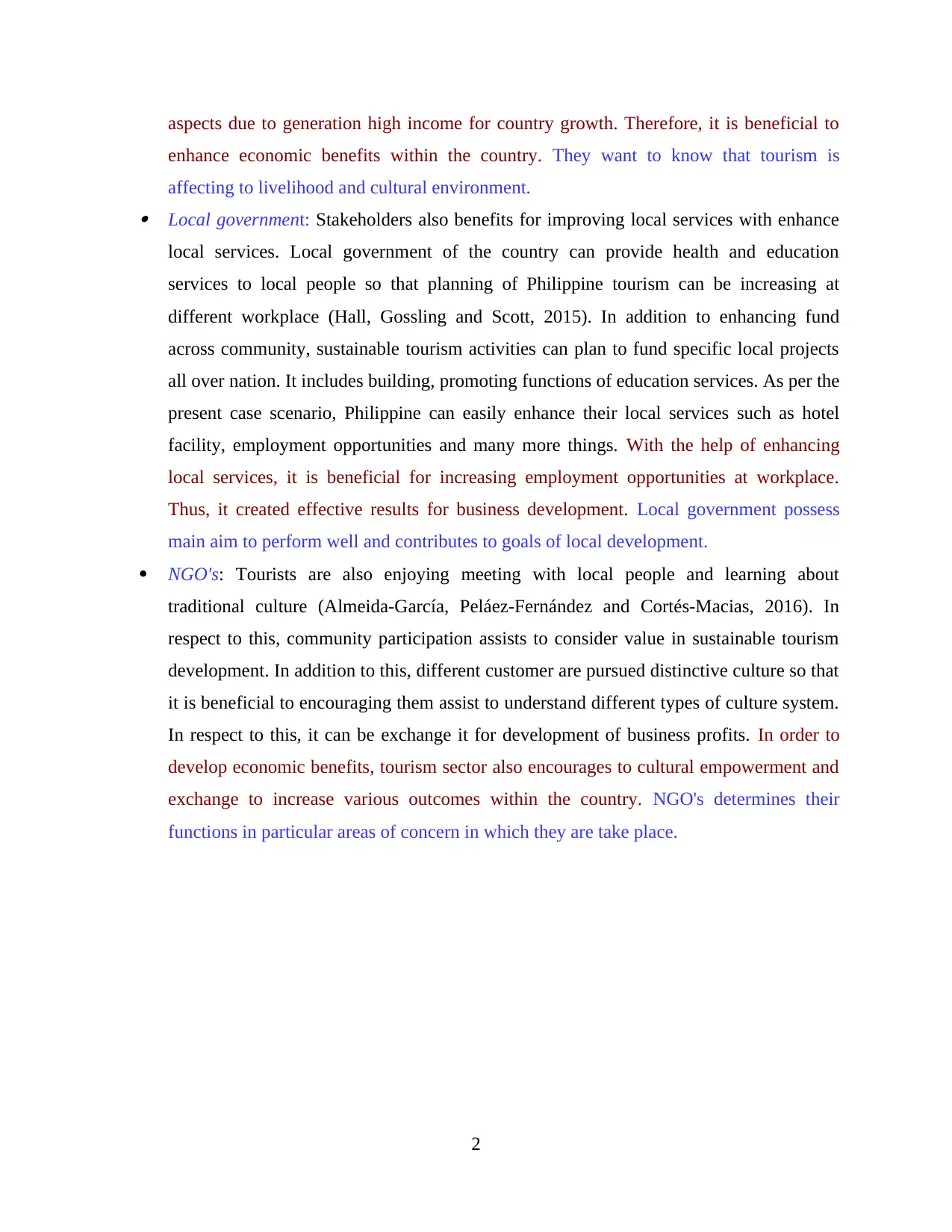
aspects due to generation high income for country growth. Therefore, it is beneficial to
enhance economic benefits within the country. They want to know that tourism is
affecting to livelihood and cultural environment. Local government: Stakeholders also benefits for improving local services with enhance
local services. Local government of the country can provide health and education
services to local people so that planning of Philippine tourism can be increasing at
different workplace (Hall, Gossling and Scott, 2015). In addition to enhancing fund
across community, sustainable tourism activities can plan to fund specific local projects
all over nation. It includes building, promoting functions of education services. As per the
present case scenario, Philippine can easily enhance their local services such as hotel
facility, employment opportunities and many more things. With the help of enhancing
local services, it is beneficial for increasing employment opportunities at workplace.
Thus, it created effective results for business development. Local government possess
main aim to perform well and contributes to goals of local development.
NGO's: Tourists are also enjoying meeting with local people and learning about
traditional culture (Almeida-García, Peláez-Fernández and Cortés-Macias, 2016). In
respect to this, community participation assists to consider value in sustainable tourism
development. In addition to this, different customer are pursued distinctive culture so that
it is beneficial to encouraging them assist to understand different types of culture system.
In respect to this, it can be exchange it for development of business profits. In order to
develop economic benefits, tourism sector also encourages to cultural empowerment and
exchange to increase various outcomes within the country. NGO's determines their
functions in particular areas of concern in which they are take place.
2
enhance economic benefits within the country. They want to know that tourism is
affecting to livelihood and cultural environment. Local government: Stakeholders also benefits for improving local services with enhance
local services. Local government of the country can provide health and education
services to local people so that planning of Philippine tourism can be increasing at
different workplace (Hall, Gossling and Scott, 2015). In addition to enhancing fund
across community, sustainable tourism activities can plan to fund specific local projects
all over nation. It includes building, promoting functions of education services. As per the
present case scenario, Philippine can easily enhance their local services such as hotel
facility, employment opportunities and many more things. With the help of enhancing
local services, it is beneficial for increasing employment opportunities at workplace.
Thus, it created effective results for business development. Local government possess
main aim to perform well and contributes to goals of local development.
NGO's: Tourists are also enjoying meeting with local people and learning about
traditional culture (Almeida-García, Peláez-Fernández and Cortés-Macias, 2016). In
respect to this, community participation assists to consider value in sustainable tourism
development. In addition to this, different customer are pursued distinctive culture so that
it is beneficial to encouraging them assist to understand different types of culture system.
In respect to this, it can be exchange it for development of business profits. In order to
develop economic benefits, tourism sector also encourages to cultural empowerment and
exchange to increase various outcomes within the country. NGO's determines their
functions in particular areas of concern in which they are take place.
2
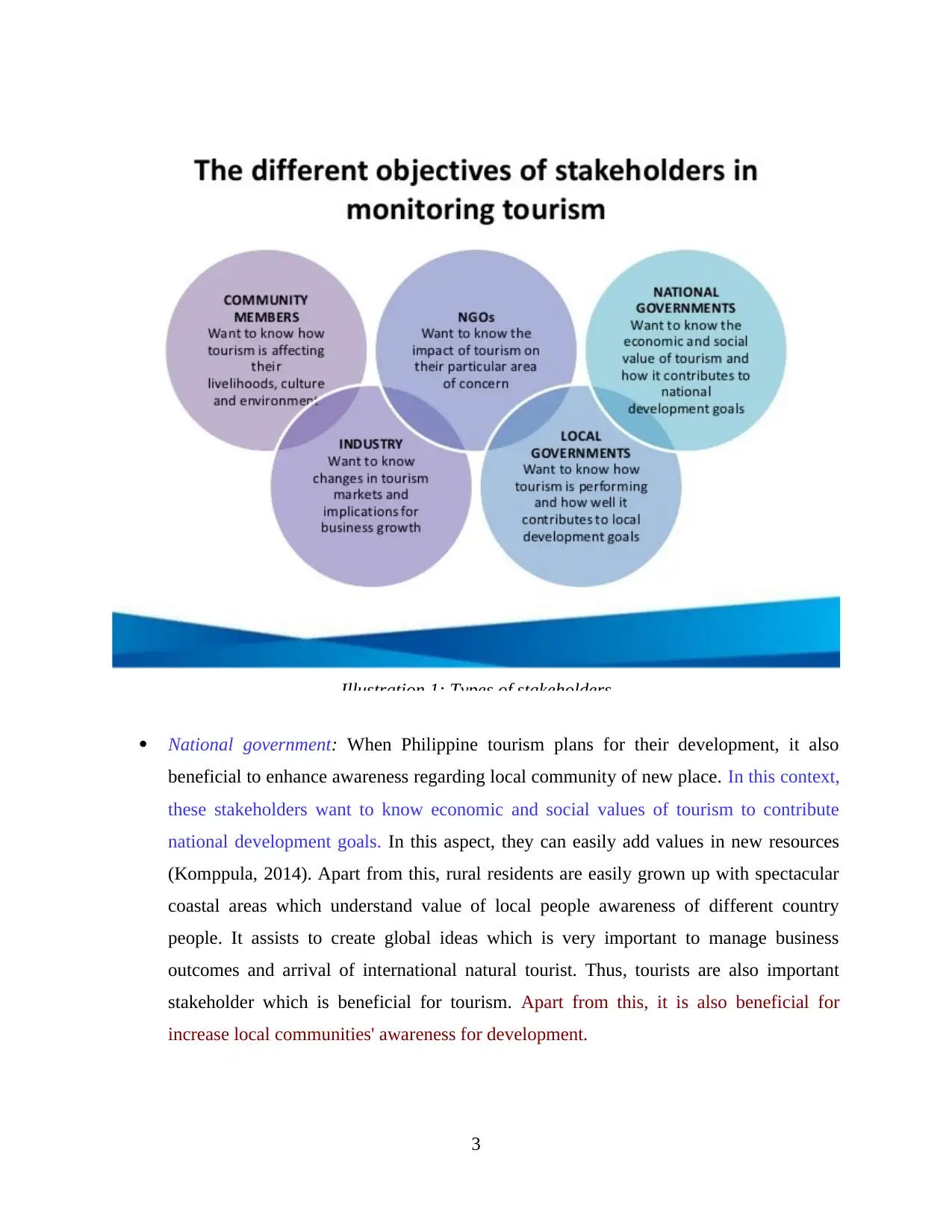
National government: When Philippine tourism plans for their development, it also
beneficial to enhance awareness regarding local community of new place. In this context,
these stakeholders want to know economic and social values of tourism to contribute
national development goals. In this aspect, they can easily add values in new resources
(Komppula, 2014). Apart from this, rural residents are easily grown up with spectacular
coastal areas which understand value of local people awareness of different country
people. It assists to create global ideas which is very important to manage business
outcomes and arrival of international natural tourist. Thus, tourists are also important
stakeholder which is beneficial for tourism. Apart from this, it is also beneficial for
increase local communities' awareness for development.
3
Illustration 1: Types of stakeholders
beneficial to enhance awareness regarding local community of new place. In this context,
these stakeholders want to know economic and social values of tourism to contribute
national development goals. In this aspect, they can easily add values in new resources
(Komppula, 2014). Apart from this, rural residents are easily grown up with spectacular
coastal areas which understand value of local people awareness of different country
people. It assists to create global ideas which is very important to manage business
outcomes and arrival of international natural tourist. Thus, tourists are also important
stakeholder which is beneficial for tourism. Apart from this, it is also beneficial for
increase local communities' awareness for development.
3
Illustration 1: Types of stakeholders
⊘ This is a preview!⊘
Do you want full access?
Subscribe today to unlock all pages.

Trusted by 1+ million students worldwide
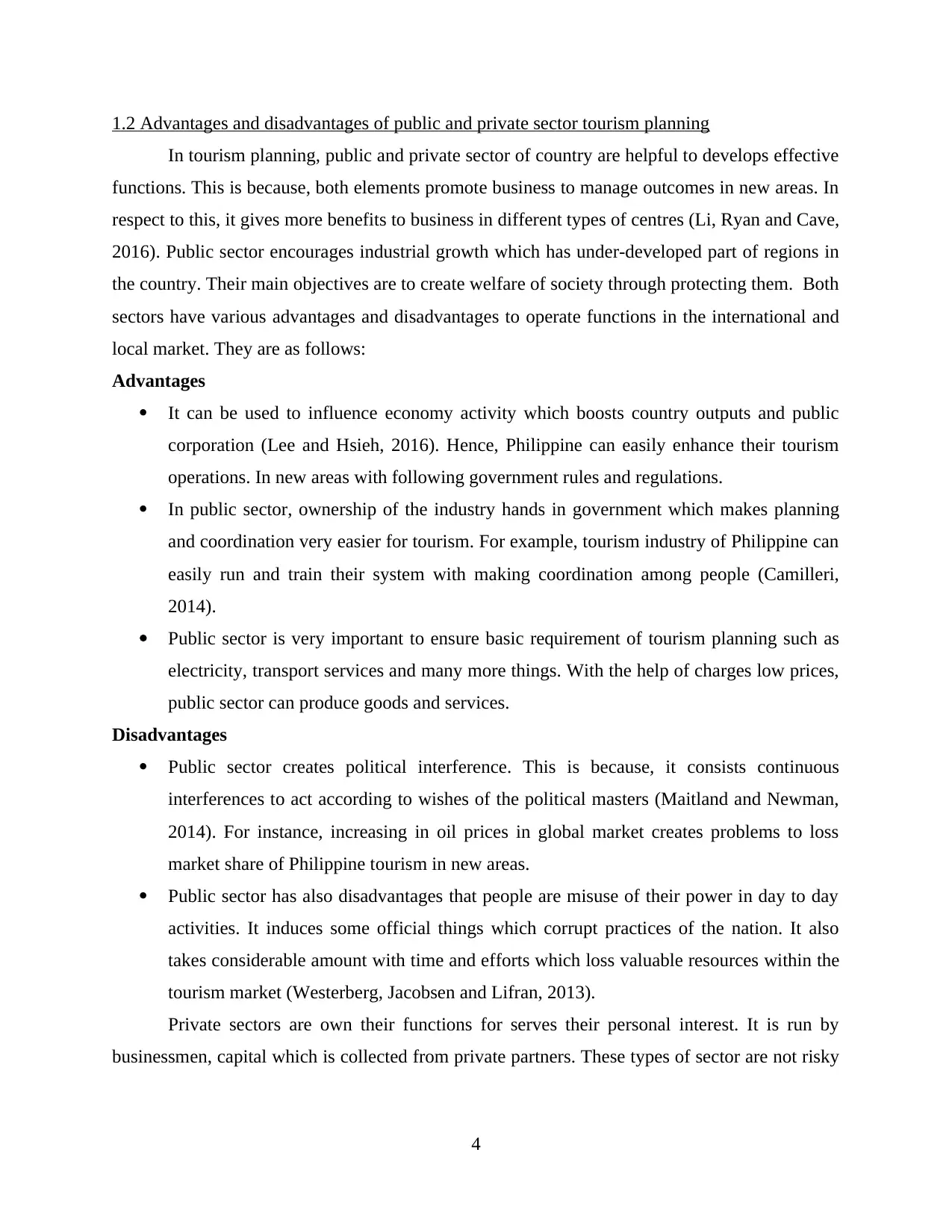
1.2 Advantages and disadvantages of public and private sector tourism planning
In tourism planning, public and private sector of country are helpful to develops effective
functions. This is because, both elements promote business to manage outcomes in new areas. In
respect to this, it gives more benefits to business in different types of centres (Li, Ryan and Cave,
2016). Public sector encourages industrial growth which has under-developed part of regions in
the country. Their main objectives are to create welfare of society through protecting them. Both
sectors have various advantages and disadvantages to operate functions in the international and
local market. They are as follows:
Advantages
It can be used to influence economy activity which boosts country outputs and public
corporation (Lee and Hsieh, 2016). Hence, Philippine can easily enhance their tourism
operations. In new areas with following government rules and regulations.
In public sector, ownership of the industry hands in government which makes planning
and coordination very easier for tourism. For example, tourism industry of Philippine can
easily run and train their system with making coordination among people (Camilleri,
2014).
Public sector is very important to ensure basic requirement of tourism planning such as
electricity, transport services and many more things. With the help of charges low prices,
public sector can produce goods and services.
Disadvantages
Public sector creates political interference. This is because, it consists continuous
interferences to act according to wishes of the political masters (Maitland and Newman,
2014). For instance, increasing in oil prices in global market creates problems to loss
market share of Philippine tourism in new areas.
Public sector has also disadvantages that people are misuse of their power in day to day
activities. It induces some official things which corrupt practices of the nation. It also
takes considerable amount with time and efforts which loss valuable resources within the
tourism market (Westerberg, Jacobsen and Lifran, 2013).
Private sectors are own their functions for serves their personal interest. It is run by
businessmen, capital which is collected from private partners. These types of sector are not risky
4
In tourism planning, public and private sector of country are helpful to develops effective
functions. This is because, both elements promote business to manage outcomes in new areas. In
respect to this, it gives more benefits to business in different types of centres (Li, Ryan and Cave,
2016). Public sector encourages industrial growth which has under-developed part of regions in
the country. Their main objectives are to create welfare of society through protecting them. Both
sectors have various advantages and disadvantages to operate functions in the international and
local market. They are as follows:
Advantages
It can be used to influence economy activity which boosts country outputs and public
corporation (Lee and Hsieh, 2016). Hence, Philippine can easily enhance their tourism
operations. In new areas with following government rules and regulations.
In public sector, ownership of the industry hands in government which makes planning
and coordination very easier for tourism. For example, tourism industry of Philippine can
easily run and train their system with making coordination among people (Camilleri,
2014).
Public sector is very important to ensure basic requirement of tourism planning such as
electricity, transport services and many more things. With the help of charges low prices,
public sector can produce goods and services.
Disadvantages
Public sector creates political interference. This is because, it consists continuous
interferences to act according to wishes of the political masters (Maitland and Newman,
2014). For instance, increasing in oil prices in global market creates problems to loss
market share of Philippine tourism in new areas.
Public sector has also disadvantages that people are misuse of their power in day to day
activities. It induces some official things which corrupt practices of the nation. It also
takes considerable amount with time and efforts which loss valuable resources within the
tourism market (Westerberg, Jacobsen and Lifran, 2013).
Private sectors are own their functions for serves their personal interest. It is run by
businessmen, capital which is collected from private partners. These types of sector are not risky
4
Paraphrase This Document
Need a fresh take? Get an instant paraphrase of this document with our AI Paraphraser
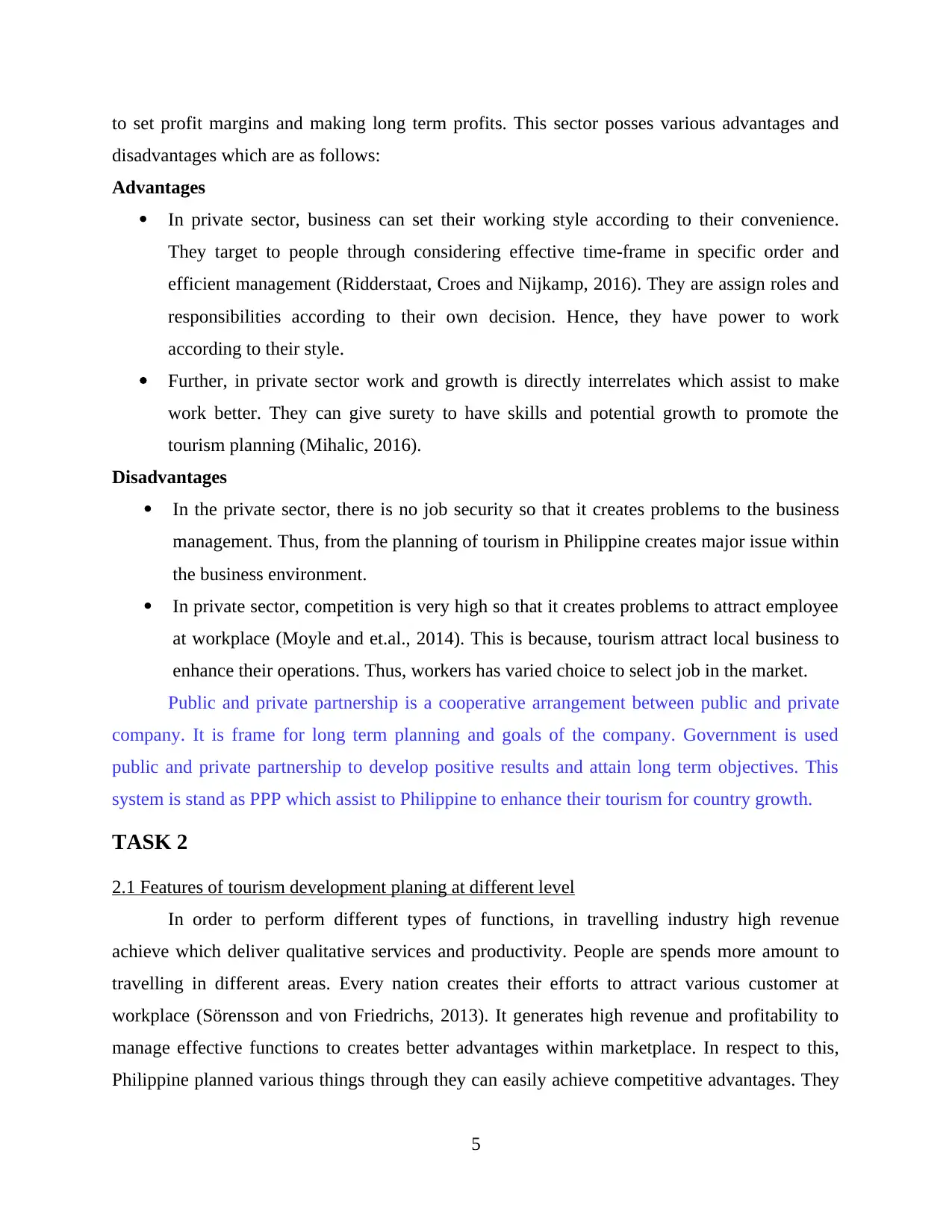
to set profit margins and making long term profits. This sector posses various advantages and
disadvantages which are as follows:
Advantages
In private sector, business can set their working style according to their convenience.
They target to people through considering effective time-frame in specific order and
efficient management (Ridderstaat, Croes and Nijkamp, 2016). They are assign roles and
responsibilities according to their own decision. Hence, they have power to work
according to their style.
Further, in private sector work and growth is directly interrelates which assist to make
work better. They can give surety to have skills and potential growth to promote the
tourism planning (Mihalic, 2016).
Disadvantages
In the private sector, there is no job security so that it creates problems to the business
management. Thus, from the planning of tourism in Philippine creates major issue within
the business environment.
In private sector, competition is very high so that it creates problems to attract employee
at workplace (Moyle and et.al., 2014). This is because, tourism attract local business to
enhance their operations. Thus, workers has varied choice to select job in the market.
Public and private partnership is a cooperative arrangement between public and private
company. It is frame for long term planning and goals of the company. Government is used
public and private partnership to develop positive results and attain long term objectives. This
system is stand as PPP which assist to Philippine to enhance their tourism for country growth.
TASK 2
2.1 Features of tourism development planing at different level
In order to perform different types of functions, in travelling industry high revenue
achieve which deliver qualitative services and productivity. People are spends more amount to
travelling in different areas. Every nation creates their efforts to attract various customer at
workplace (Sörensson and von Friedrichs, 2013). It generates high revenue and profitability to
manage effective functions to creates better advantages within marketplace. In respect to this,
Philippine planned various things through they can easily achieve competitive advantages. They
5
disadvantages which are as follows:
Advantages
In private sector, business can set their working style according to their convenience.
They target to people through considering effective time-frame in specific order and
efficient management (Ridderstaat, Croes and Nijkamp, 2016). They are assign roles and
responsibilities according to their own decision. Hence, they have power to work
according to their style.
Further, in private sector work and growth is directly interrelates which assist to make
work better. They can give surety to have skills and potential growth to promote the
tourism planning (Mihalic, 2016).
Disadvantages
In the private sector, there is no job security so that it creates problems to the business
management. Thus, from the planning of tourism in Philippine creates major issue within
the business environment.
In private sector, competition is very high so that it creates problems to attract employee
at workplace (Moyle and et.al., 2014). This is because, tourism attract local business to
enhance their operations. Thus, workers has varied choice to select job in the market.
Public and private partnership is a cooperative arrangement between public and private
company. It is frame for long term planning and goals of the company. Government is used
public and private partnership to develop positive results and attain long term objectives. This
system is stand as PPP which assist to Philippine to enhance their tourism for country growth.
TASK 2
2.1 Features of tourism development planing at different level
In order to perform different types of functions, in travelling industry high revenue
achieve which deliver qualitative services and productivity. People are spends more amount to
travelling in different areas. Every nation creates their efforts to attract various customer at
workplace (Sörensson and von Friedrichs, 2013). It generates high revenue and profitability to
manage effective functions to creates better advantages within marketplace. In respect to this,
Philippine planned various things through they can easily achieve competitive advantages. They
5
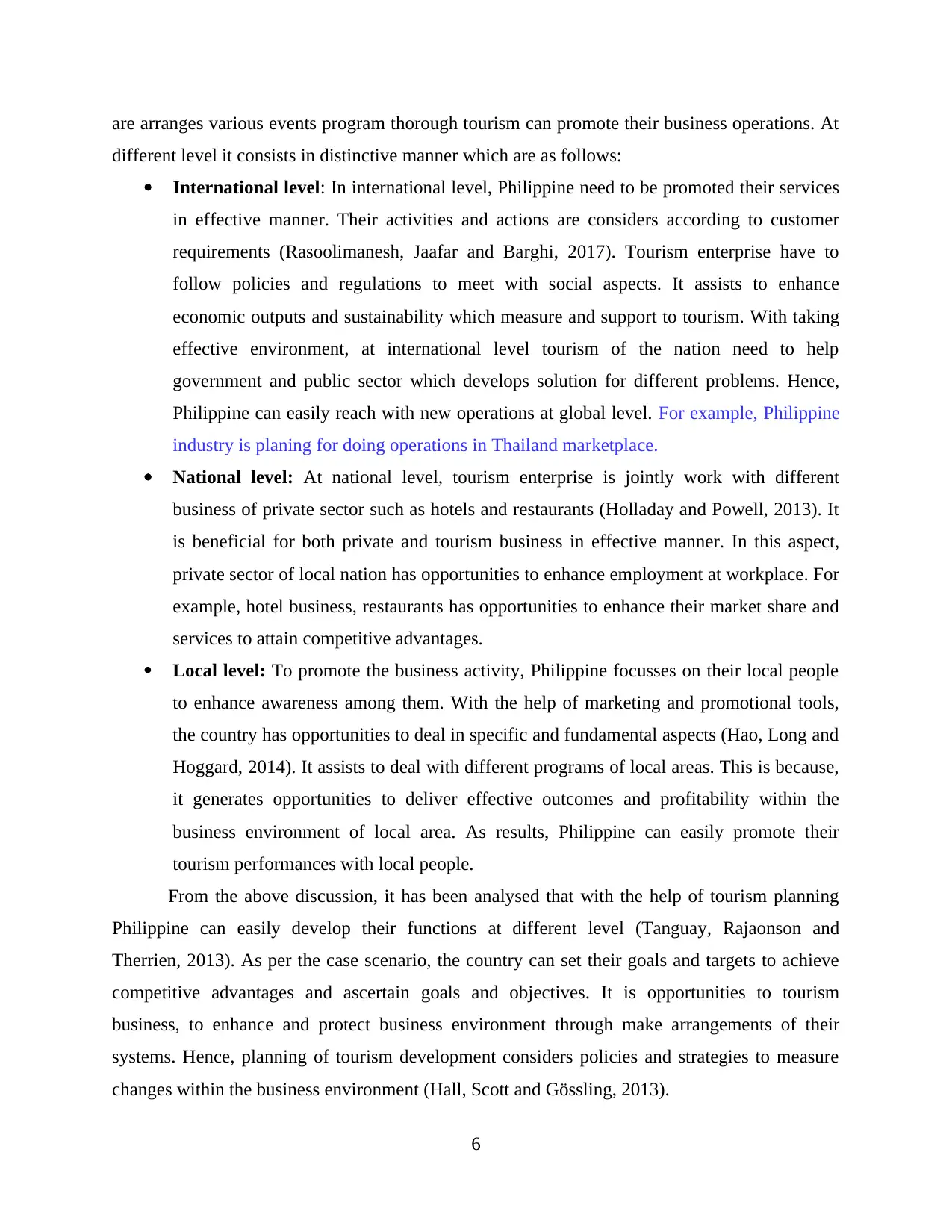
are arranges various events program thorough tourism can promote their business operations. At
different level it consists in distinctive manner which are as follows:
International level: In international level, Philippine need to be promoted their services
in effective manner. Their activities and actions are considers according to customer
requirements (Rasoolimanesh, Jaafar and Barghi, 2017). Tourism enterprise have to
follow policies and regulations to meet with social aspects. It assists to enhance
economic outputs and sustainability which measure and support to tourism. With taking
effective environment, at international level tourism of the nation need to help
government and public sector which develops solution for different problems. Hence,
Philippine can easily reach with new operations at global level. For example, Philippine
industry is planing for doing operations in Thailand marketplace.
National level: At national level, tourism enterprise is jointly work with different
business of private sector such as hotels and restaurants (Holladay and Powell, 2013). It
is beneficial for both private and tourism business in effective manner. In this aspect,
private sector of local nation has opportunities to enhance employment at workplace. For
example, hotel business, restaurants has opportunities to enhance their market share and
services to attain competitive advantages.
Local level: To promote the business activity, Philippine focusses on their local people
to enhance awareness among them. With the help of marketing and promotional tools,
the country has opportunities to deal in specific and fundamental aspects (Hao, Long and
Hoggard, 2014). It assists to deal with different programs of local areas. This is because,
it generates opportunities to deliver effective outcomes and profitability within the
business environment of local area. As results, Philippine can easily promote their
tourism performances with local people.
From the above discussion, it has been analysed that with the help of tourism planning
Philippine can easily develop their functions at different level (Tanguay, Rajaonson and
Therrien, 2013). As per the case scenario, the country can set their goals and targets to achieve
competitive advantages and ascertain goals and objectives. It is opportunities to tourism
business, to enhance and protect business environment through make arrangements of their
systems. Hence, planning of tourism development considers policies and strategies to measure
changes within the business environment (Hall, Scott and Gössling, 2013).
6
different level it consists in distinctive manner which are as follows:
International level: In international level, Philippine need to be promoted their services
in effective manner. Their activities and actions are considers according to customer
requirements (Rasoolimanesh, Jaafar and Barghi, 2017). Tourism enterprise have to
follow policies and regulations to meet with social aspects. It assists to enhance
economic outputs and sustainability which measure and support to tourism. With taking
effective environment, at international level tourism of the nation need to help
government and public sector which develops solution for different problems. Hence,
Philippine can easily reach with new operations at global level. For example, Philippine
industry is planing for doing operations in Thailand marketplace.
National level: At national level, tourism enterprise is jointly work with different
business of private sector such as hotels and restaurants (Holladay and Powell, 2013). It
is beneficial for both private and tourism business in effective manner. In this aspect,
private sector of local nation has opportunities to enhance employment at workplace. For
example, hotel business, restaurants has opportunities to enhance their market share and
services to attain competitive advantages.
Local level: To promote the business activity, Philippine focusses on their local people
to enhance awareness among them. With the help of marketing and promotional tools,
the country has opportunities to deal in specific and fundamental aspects (Hao, Long and
Hoggard, 2014). It assists to deal with different programs of local areas. This is because,
it generates opportunities to deliver effective outcomes and profitability within the
business environment of local area. As results, Philippine can easily promote their
tourism performances with local people.
From the above discussion, it has been analysed that with the help of tourism planning
Philippine can easily develop their functions at different level (Tanguay, Rajaonson and
Therrien, 2013). As per the case scenario, the country can set their goals and targets to achieve
competitive advantages and ascertain goals and objectives. It is opportunities to tourism
business, to enhance and protect business environment through make arrangements of their
systems. Hence, planning of tourism development considers policies and strategies to measure
changes within the business environment (Hall, Scott and Gössling, 2013).
6
⊘ This is a preview!⊘
Do you want full access?
Subscribe today to unlock all pages.

Trusted by 1+ million students worldwide
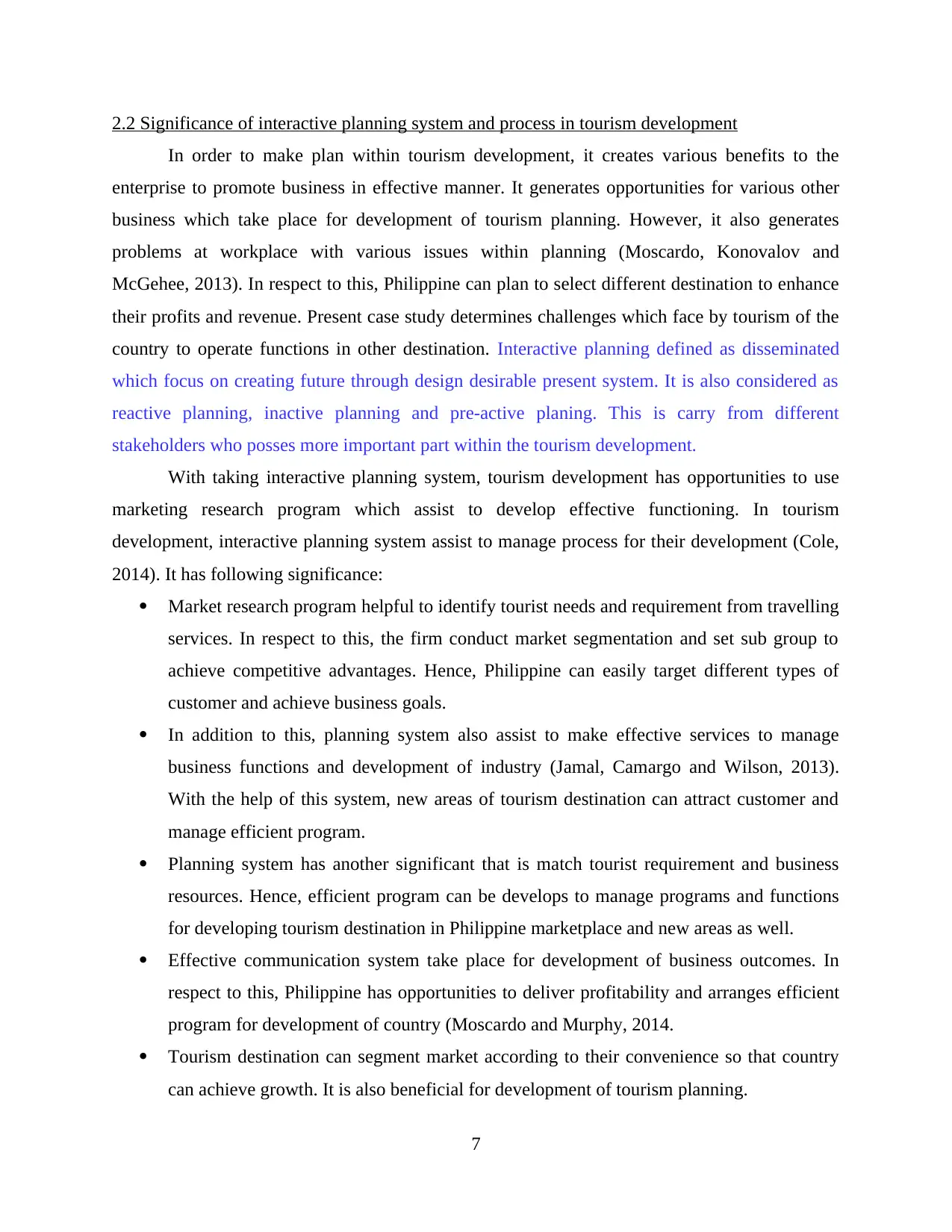
2.2 Significance of interactive planning system and process in tourism development
In order to make plan within tourism development, it creates various benefits to the
enterprise to promote business in effective manner. It generates opportunities for various other
business which take place for development of tourism planning. However, it also generates
problems at workplace with various issues within planning (Moscardo, Konovalov and
McGehee, 2013). In respect to this, Philippine can plan to select different destination to enhance
their profits and revenue. Present case study determines challenges which face by tourism of the
country to operate functions in other destination. Interactive planning defined as disseminated
which focus on creating future through design desirable present system. It is also considered as
reactive planning, inactive planning and pre-active planing. This is carry from different
stakeholders who posses more important part within the tourism development.
With taking interactive planning system, tourism development has opportunities to use
marketing research program which assist to develop effective functioning. In tourism
development, interactive planning system assist to manage process for their development (Cole,
2014). It has following significance:
Market research program helpful to identify tourist needs and requirement from travelling
services. In respect to this, the firm conduct market segmentation and set sub group to
achieve competitive advantages. Hence, Philippine can easily target different types of
customer and achieve business goals.
In addition to this, planning system also assist to make effective services to manage
business functions and development of industry (Jamal, Camargo and Wilson, 2013).
With the help of this system, new areas of tourism destination can attract customer and
manage efficient program.
Planning system has another significant that is match tourist requirement and business
resources. Hence, efficient program can be develops to manage programs and functions
for developing tourism destination in Philippine marketplace and new areas as well.
Effective communication system take place for development of business outcomes. In
respect to this, Philippine has opportunities to deliver profitability and arranges efficient
program for development of country (Moscardo and Murphy, 2014.
Tourism destination can segment market according to their convenience so that country
can achieve growth. It is also beneficial for development of tourism planning.
7
In order to make plan within tourism development, it creates various benefits to the
enterprise to promote business in effective manner. It generates opportunities for various other
business which take place for development of tourism planning. However, it also generates
problems at workplace with various issues within planning (Moscardo, Konovalov and
McGehee, 2013). In respect to this, Philippine can plan to select different destination to enhance
their profits and revenue. Present case study determines challenges which face by tourism of the
country to operate functions in other destination. Interactive planning defined as disseminated
which focus on creating future through design desirable present system. It is also considered as
reactive planning, inactive planning and pre-active planing. This is carry from different
stakeholders who posses more important part within the tourism development.
With taking interactive planning system, tourism development has opportunities to use
marketing research program which assist to develop effective functioning. In tourism
development, interactive planning system assist to manage process for their development (Cole,
2014). It has following significance:
Market research program helpful to identify tourist needs and requirement from travelling
services. In respect to this, the firm conduct market segmentation and set sub group to
achieve competitive advantages. Hence, Philippine can easily target different types of
customer and achieve business goals.
In addition to this, planning system also assist to make effective services to manage
business functions and development of industry (Jamal, Camargo and Wilson, 2013).
With the help of this system, new areas of tourism destination can attract customer and
manage efficient program.
Planning system has another significant that is match tourist requirement and business
resources. Hence, efficient program can be develops to manage programs and functions
for developing tourism destination in Philippine marketplace and new areas as well.
Effective communication system take place for development of business outcomes. In
respect to this, Philippine has opportunities to deliver profitability and arranges efficient
program for development of country (Moscardo and Murphy, 2014.
Tourism destination can segment market according to their convenience so that country
can achieve growth. It is also beneficial for development of tourism planning.
7
Paraphrase This Document
Need a fresh take? Get an instant paraphrase of this document with our AI Paraphraser
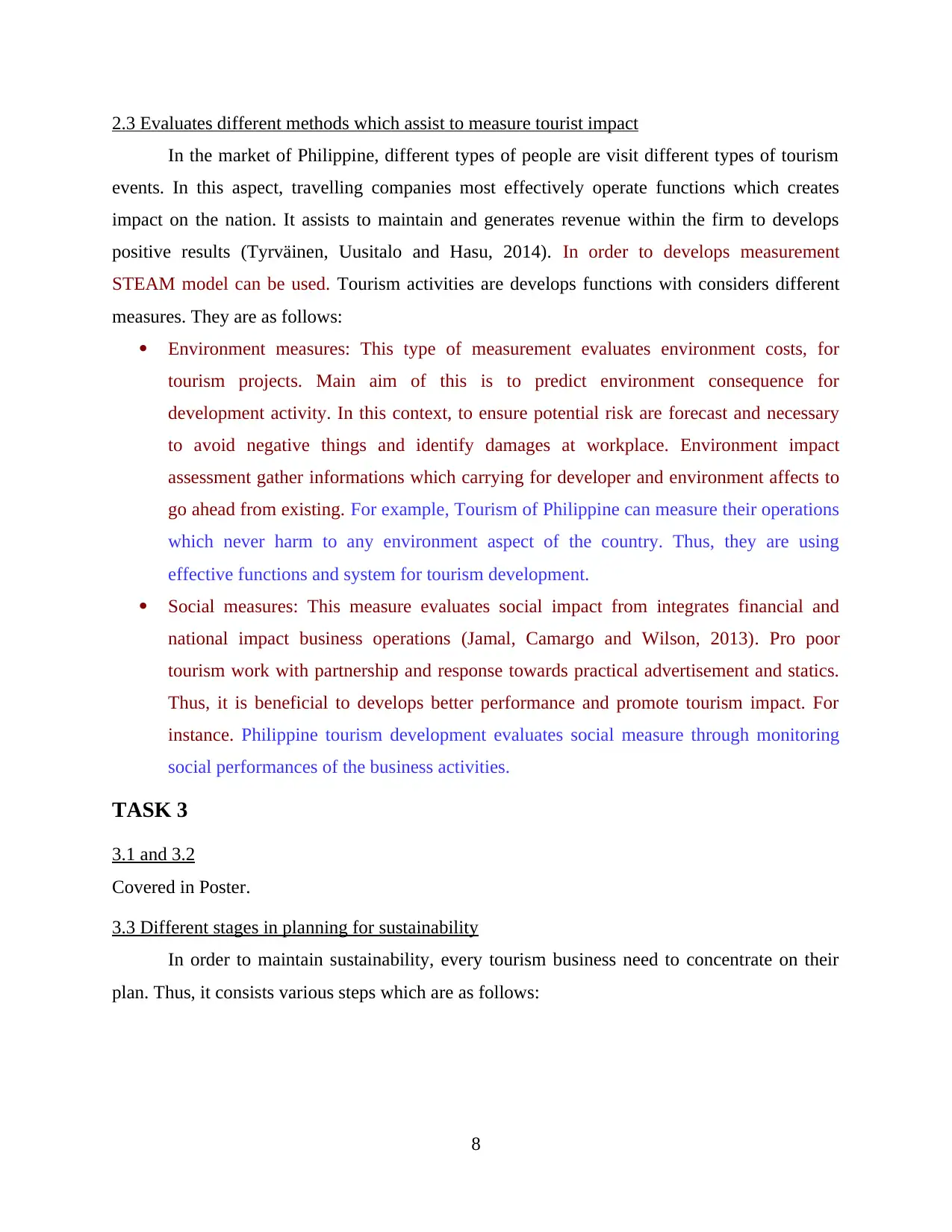
2.3 Evaluates different methods which assist to measure tourist impact
In the market of Philippine, different types of people are visit different types of tourism
events. In this aspect, travelling companies most effectively operate functions which creates
impact on the nation. It assists to maintain and generates revenue within the firm to develops
positive results (Tyrväinen, Uusitalo and Hasu, 2014). In order to develops measurement
STEAM model can be used. Tourism activities are develops functions with considers different
measures. They are as follows:
Environment measures: This type of measurement evaluates environment costs, for
tourism projects. Main aim of this is to predict environment consequence for
development activity. In this context, to ensure potential risk are forecast and necessary
to avoid negative things and identify damages at workplace. Environment impact
assessment gather informations which carrying for developer and environment affects to
go ahead from existing. For example, Tourism of Philippine can measure their operations
which never harm to any environment aspect of the country. Thus, they are using
effective functions and system for tourism development.
Social measures: This measure evaluates social impact from integrates financial and
national impact business operations (Jamal, Camargo and Wilson, 2013). Pro poor
tourism work with partnership and response towards practical advertisement and statics.
Thus, it is beneficial to develops better performance and promote tourism impact. For
instance. Philippine tourism development evaluates social measure through monitoring
social performances of the business activities.
TASK 3
3.1 and 3.2
Covered in Poster.
3.3 Different stages in planning for sustainability
In order to maintain sustainability, every tourism business need to concentrate on their
plan. Thus, it consists various steps which are as follows:
8
In the market of Philippine, different types of people are visit different types of tourism
events. In this aspect, travelling companies most effectively operate functions which creates
impact on the nation. It assists to maintain and generates revenue within the firm to develops
positive results (Tyrväinen, Uusitalo and Hasu, 2014). In order to develops measurement
STEAM model can be used. Tourism activities are develops functions with considers different
measures. They are as follows:
Environment measures: This type of measurement evaluates environment costs, for
tourism projects. Main aim of this is to predict environment consequence for
development activity. In this context, to ensure potential risk are forecast and necessary
to avoid negative things and identify damages at workplace. Environment impact
assessment gather informations which carrying for developer and environment affects to
go ahead from existing. For example, Tourism of Philippine can measure their operations
which never harm to any environment aspect of the country. Thus, they are using
effective functions and system for tourism development.
Social measures: This measure evaluates social impact from integrates financial and
national impact business operations (Jamal, Camargo and Wilson, 2013). Pro poor
tourism work with partnership and response towards practical advertisement and statics.
Thus, it is beneficial to develops better performance and promote tourism impact. For
instance. Philippine tourism development evaluates social measure through monitoring
social performances of the business activities.
TASK 3
3.1 and 3.2
Covered in Poster.
3.3 Different stages in planning for sustainability
In order to maintain sustainability, every tourism business need to concentrate on their
plan. Thus, it consists various steps which are as follows:
8
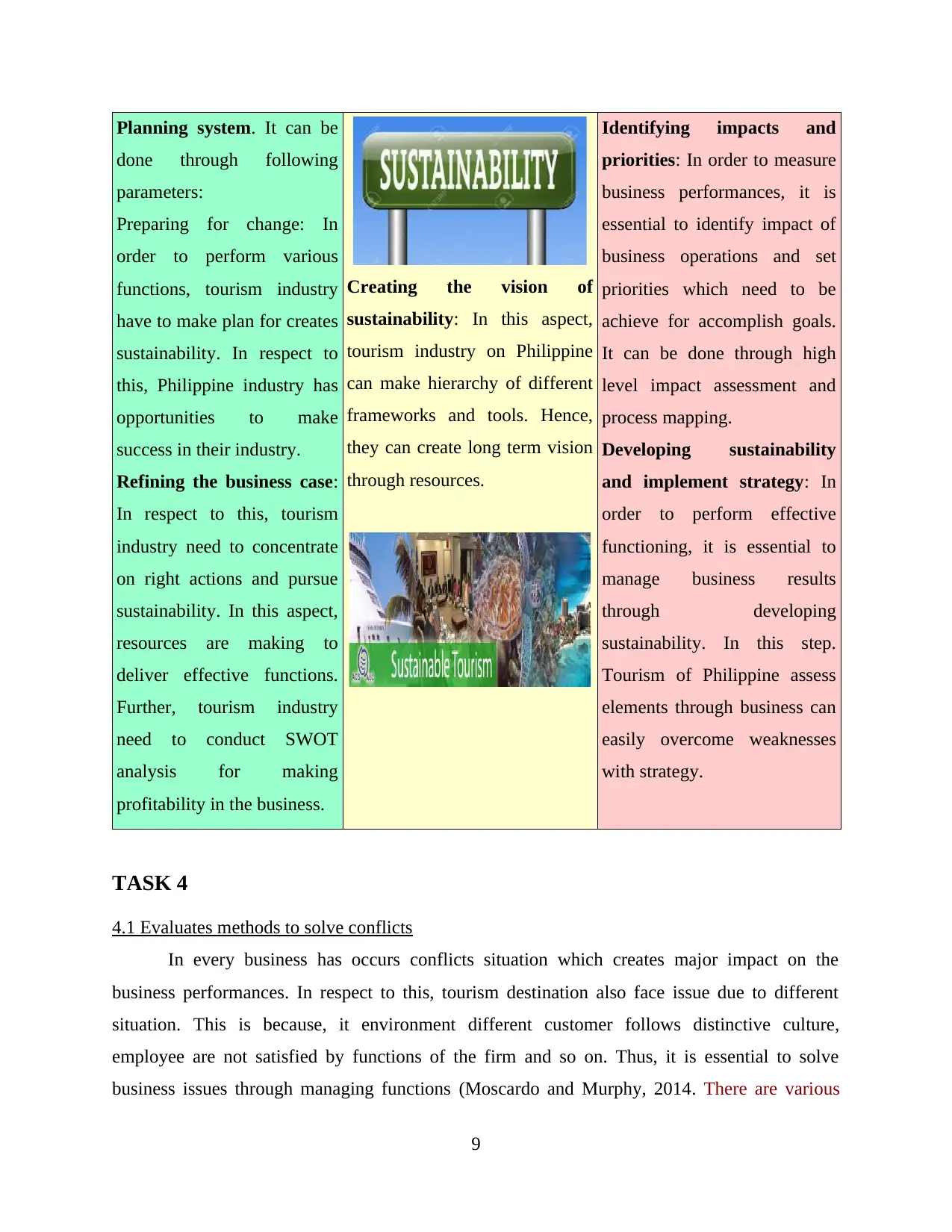
Planning system. It can be
done through following
parameters:
Preparing for change: In
order to perform various
functions, tourism industry
have to make plan for creates
sustainability. In respect to
this, Philippine industry has
opportunities to make
success in their industry.
Refining the business case:
In respect to this, tourism
industry need to concentrate
on right actions and pursue
sustainability. In this aspect,
resources are making to
deliver effective functions.
Further, tourism industry
need to conduct SWOT
analysis for making
profitability in the business.
Creating the vision of
sustainability: In this aspect,
tourism industry on Philippine
can make hierarchy of different
frameworks and tools. Hence,
they can create long term vision
through resources.
Identifying impacts and
priorities: In order to measure
business performances, it is
essential to identify impact of
business operations and set
priorities which need to be
achieve for accomplish goals.
It can be done through high
level impact assessment and
process mapping.
Developing sustainability
and implement strategy: In
order to perform effective
functioning, it is essential to
manage business results
through developing
sustainability. In this step.
Tourism of Philippine assess
elements through business can
easily overcome weaknesses
with strategy.
TASK 4
4.1 Evaluates methods to solve conflicts
In every business has occurs conflicts situation which creates major impact on the
business performances. In respect to this, tourism destination also face issue due to different
situation. This is because, it environment different customer follows distinctive culture,
employee are not satisfied by functions of the firm and so on. Thus, it is essential to solve
business issues through managing functions (Moscardo and Murphy, 2014. There are various
9
done through following
parameters:
Preparing for change: In
order to perform various
functions, tourism industry
have to make plan for creates
sustainability. In respect to
this, Philippine industry has
opportunities to make
success in their industry.
Refining the business case:
In respect to this, tourism
industry need to concentrate
on right actions and pursue
sustainability. In this aspect,
resources are making to
deliver effective functions.
Further, tourism industry
need to conduct SWOT
analysis for making
profitability in the business.
Creating the vision of
sustainability: In this aspect,
tourism industry on Philippine
can make hierarchy of different
frameworks and tools. Hence,
they can create long term vision
through resources.
Identifying impacts and
priorities: In order to measure
business performances, it is
essential to identify impact of
business operations and set
priorities which need to be
achieve for accomplish goals.
It can be done through high
level impact assessment and
process mapping.
Developing sustainability
and implement strategy: In
order to perform effective
functioning, it is essential to
manage business results
through developing
sustainability. In this step.
Tourism of Philippine assess
elements through business can
easily overcome weaknesses
with strategy.
TASK 4
4.1 Evaluates methods to solve conflicts
In every business has occurs conflicts situation which creates major impact on the
business performances. In respect to this, tourism destination also face issue due to different
situation. This is because, it environment different customer follows distinctive culture,
employee are not satisfied by functions of the firm and so on. Thus, it is essential to solve
business issues through managing functions (Moscardo and Murphy, 2014. There are various
9
⊘ This is a preview!⊘
Do you want full access?
Subscribe today to unlock all pages.

Trusted by 1+ million students worldwide
1 out of 22
Related Documents
Your All-in-One AI-Powered Toolkit for Academic Success.
+13062052269
info@desklib.com
Available 24*7 on WhatsApp / Email
![[object Object]](/_next/static/media/star-bottom.7253800d.svg)
Unlock your academic potential
Copyright © 2020–2025 A2Z Services. All Rights Reserved. Developed and managed by ZUCOL.





